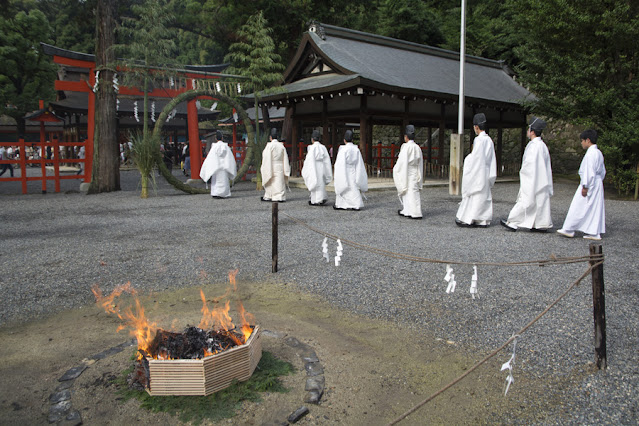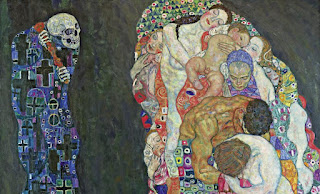Research: Shinto
In order to start to develop research about kami's (gods, goddesses and deities) I felt like I needed to understand the Shinto religion first and what kami's mean to the Japanese culture and population.
Shinto
The word Shinto (神道) literally means "The way of Kami", it came from the Chinese characters "shen" (divine being) and "tao" (way). This religion was originated in Japan and it is separated from the state, it also does not possess any founder, sacred scriptures and fixed dogmas. Instead it is a moral code, which commands the way of living: religion in Japan is rarely discussed in every day life and the majority of the Japanese don't recognize themselves as religious. In other words, the religion for them consist in beliefs, attitudes towards life and traditional Japanese religious practices.
Shinto is the largest religion in Japan and the fifth largest religion around the world. Around 80% of the Japanese population practices it which means that it has a little more than 100 million followers. However, this religion is rarely practiced outside of Japan since it is an ethnic religion and it is focused mostly on its country of origin.
Shinto is distinguished by religious scholars into different categories, some of them are: Shrine Shinto, Sec Shinto, Folk Shinto and Imperial Household Shinto. The Shrine Shinto (Jinja Shintō) is one of the largest traditions of the religion and has been part of Japan's History since its very beginning.The Sec Shinto (Kyōha Shintō) was created to differ the shrines from the national governement and the local community shrines. The main difference between the Shrine Shinto and the Sec Shinto is that this last identifies a founder, a set of scriptures and a set of teachings. The Folk Shinto (Minzoku Shintō) has no formal organizational structure and it is focused on the veneration of small roadside images and in agricultural rites. Their practices include divination, spirit possession and shaman healing. Finally, there is also the Imperial Household Shinto or State Shinto (Kokka Shintō) which includes the rituals and traditions of the imperial family.
As I mentioned in previous posts, Shinto is a polytheist religion: it is said that there are eight million Kami. However, this number is normally associated with "infinity" in Japan. Therefore, it is possible to conclude there the number of kamis is infinite. In order to pay respect to the kami or even just to pray for good fortune, people visit shinto shrines (神社, jinja). It is estimated that there is over 80,000 shirnes in whole Japan. These are places of worship and are known as the homes of kami and it is in stored in them sacred objects that represent the kami. They are visited as well during special events of the year such as New Year, Setsubun (節分, which means 'seasonal division'), Shichi-go-san (七五三,which means literally '7-5-3') and other festivals. Furthermore, new born babies are normally brought to a shrine and there are commonely wedding ceremonies hold in there.
In terms of rituals, there are shinto priests that perform these on shrine grounds. Both, men and women, can become priests and are even allowed to marry and have children. During rituals, the priests are helped by miko's (young women) - normally the priests' daughters.
Furthermore, in Shinto there is no sacred book as in Christianism for example. However, it can be found 4 different stories which explain many beliefs of Shinto: Kojiki (The Record of Ancient Matters); Shoku Nihongi (Chronicles of Japan), Jinno Shotoki (Shinto Politics) and last but not least, the Rikkokushi (National Histories).
Now that I already have a better understanding of this religion and how the Japanese society sees it, I will develop further research around the Kami, in general and some in separate. At the moment I believe that I am in the middle of my research, so I expect to develop my first sketches next week so that I can start to work on the final results in week 6.
Reference:
eCondolence (n.d.) Understanding Shinto [online] Available from:
https://www.econdolence.com/learning-center/religion-and-culture/shinto/understanding-shinto/ [Accessed 16.04.2021]
Britannica Academic (2020) Shintō [online] Available from: https://academic-eb-com.proxy.library.dmu.ac.uk/levels/collegiate/article/Shint%C5%8D/105864
[Accessed 16.04.2021]
BBC (2011) Shinto at a glance [online] Available from: https://www.bbc.co.uk/religion/religions/shinto/ataglance/glance.shtml [Accessed 19.04.2021]
Japan Guide (2020) Shinto [online] Available from: https://www.japan-guide.com/e/e2056.html [19.04.2021]
Japan Guide (2020) Shrine [online] Available from:https://www.japan-guide.com/e/e2059.html [Accessed 23.04.2021]




Comments
Post a Comment